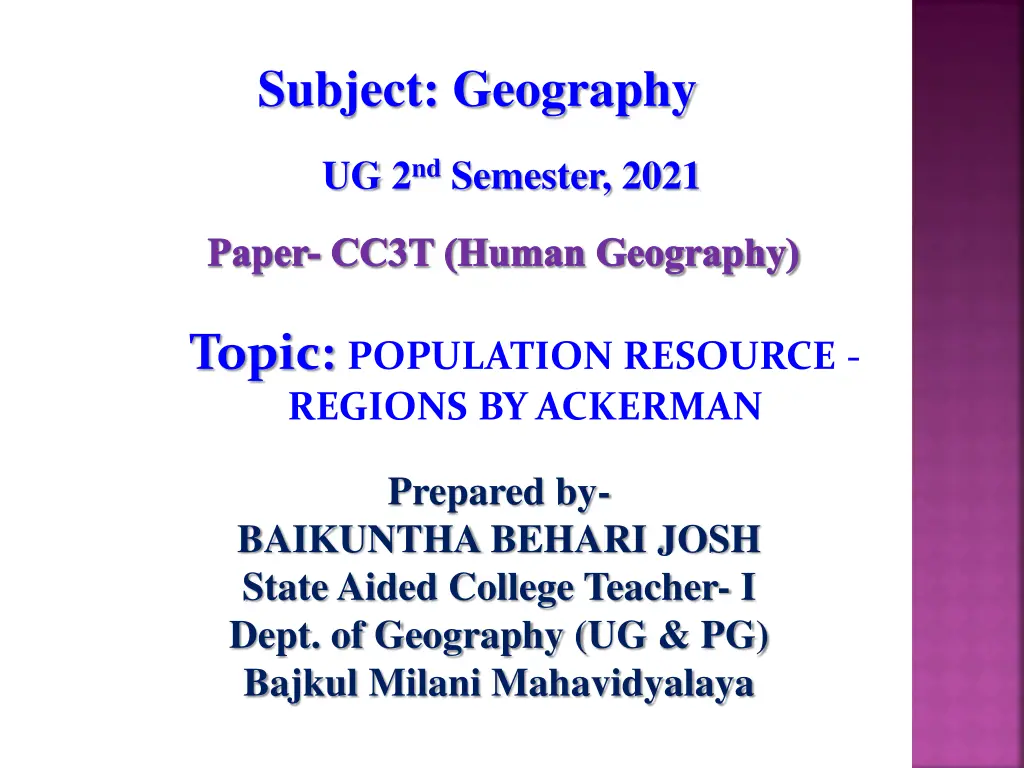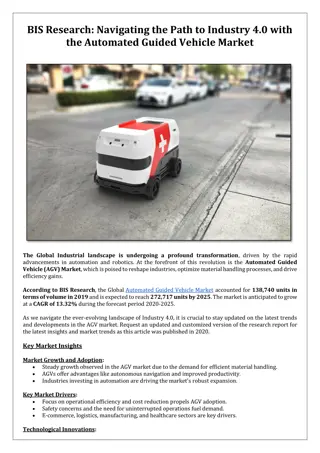
Analysis of Population Resource Regions by Ackerman in Human Geography Study
Explore Edward A. Ackerman's classification of the world into population/resource regions based on ratios and technology availability. Learn about the United States, European, Brazilian, Egyptian, and Arctic-desert types, each with unique characteristics in population, resources, and technology. Gain insights into the impact of technology on development and sustainability in different regions.
Download Presentation

Please find below an Image/Link to download the presentation.
The content on the website is provided AS IS for your information and personal use only. It may not be sold, licensed, or shared on other websites without obtaining consent from the author. If you encounter any issues during the download, it is possible that the publisher has removed the file from their server.
You are allowed to download the files provided on this website for personal or commercial use, subject to the condition that they are used lawfully. All files are the property of their respective owners.
The content on the website is provided AS IS for your information and personal use only. It may not be sold, licensed, or shared on other websites without obtaining consent from the author.
E N D
Presentation Transcript
Subject: Geography UG 2nd Semester, 2021 Paper- CC3T (Human Geography) Topic: POPULATION RESOURCE - REGIONS BY ACKERMAN Prepared by- BAIKUNTHA BEHARI JOSH State Aided College Teacher- I Dept. of Geography (UG & PG) Bajkul Milani Mahavidyalaya
POPULATION RESOURCE - REGIONS BY ACKERMAN on the basis of population resource ratio only reinforces the difficulties involved in quantification of the two main factors of population and resources. In this regard perhaps the most meaningful effort has been made by Edward A. Ackerman in 1970. significant and
For the regionalization of the world Ackerman stated three fundamental variables: 1. Population 2. Resource and 3. Technology Among these three variables used in this scheme, the most critical is the magnitude and quality of available technology. He suggested a five-fold classification of the world into population/ resource region on the basis of population resource ratios and the availability of technology.
Population resource regions of the world 1. Technology-source areas of low population/ resources ratio or United States type 2. Technology-source areas of high population/ resources ratio, or the European type 3. Technology- deficient population/ resources ratio, or the Brazilian type 4. Technology- deficient area of high population / resources ratio, or the Egyptian type. 5. Technology- deficient areas possessing a few food producing resources, or the Arctic-desert type areas of low
(1)The United States Types: These areas are the most developed areas of the world enjoying very high standard of living. They witness rapid development in last one to two hundred years as they received massive in-migration from then technically very advance society. In fact at that time most of them belong to Brazilian type. Original inhabitants of these lands were low in numbers, technically very backward and so they gave up quickly against migrants. These lands were full of pristine natural resources and thus technological support gave them very high growth and prosperity. In contrast to their physical resources the population pressure was very low and so there was always a good scope for the application of higher and higher technology.
Slowly they mastered in technology and now the area has so much technology and so many technical persons that they often export them. Their prosperity, wealth and technical knowhow gave them unprecedented advantage in international arena to deal things in their favour. They use resource of not only of their own land but also of other regions. This unfortunate excessive materialistic attitude has done much harm to the nature. Probably they are at the zenith of development using present technological knowhow and the gap between them and the next group is so high that it seems difficult that any new country will be added to this group in near future, instead it is more possible that some of them may slip down to lower group
(2) The European Type: This is the source area of massive out-migration to new lands which developed into United States type latter. Here again technology is very advance but high population and limited physical resources has created high population pressure. High living standard is maintained by constant technological up gradation, resource conservation and recycling, one of the best output practices along with export of technology, technical knowhow and export of finished goods. So their prosperity relies on a combination of advance technology, efficient resource utilization and conservation and on international trade and services
(3) Brazilian Types: This is practically a transition stage were the pressure of population to physical resources is low and so these areas have high promises. They have ample physical resources but their technologies are poor and so their prosperity are average. If they receive or develop good technology, sufficient social overhead capital, etc. then their resource exploitation efficiency will expand and it will bring them to a trajectory of higher prosperity like of European type. If only population expand and not technology and quality of population, then such region may slip to the inferior category of China type
(4) Egyptian Types: This is the least promising of all categories. State of technology is poor and excessive population has caused very high stress on physical resources. So, industrialization is low, agriculture which is the mainstay of economy is in dilapidated condition and high population is expanding at higher rate. Many social issues like poverty, unemployment, malnutrition, illiteracy, etc. are very common. Probably rapid population growth is the biggest single problem here which if controlled then only this region has chance of moving towards European type of prosperity.
5. Arctic Desert Type Regions This type of regions include vast expanses of areas which are suffering under extreme climatic conditions and have remained either entirely uninhabited or are very sparsely populated mainly due to excessive cold, aridity or inhospitable terrain. These are the homelands of small marginal groups like the Eskimos, Lapps, Bushmen, Negroes, etc. These regions are technologically deficient, sparsely populated and have scarse food resources. There are no settlements at all in most of these areas. These areas are mostly deserted either due to extreme cold (Tundra regions) or aridity (hot deserts).












